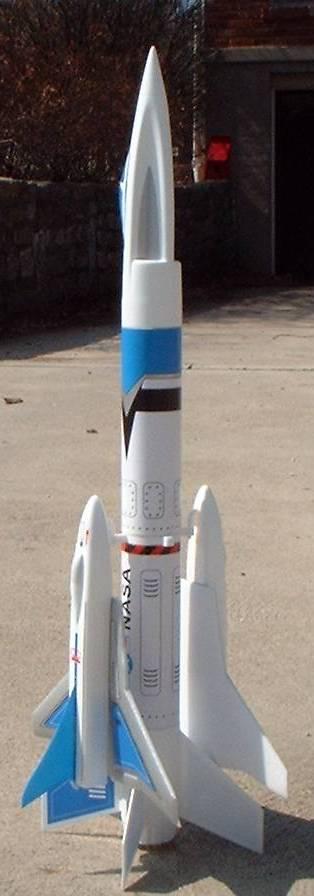| Construction Rating: | starstarstarstarstar_border |
| Flight Rating: | starstarstarstar_borderstar_border |
| Overall Rating: | starstarstarstarstar_border |
| Diameter: | 1.33 inches |
| Length: | 17.70 inches |
| Manufacturer: | Estes  |
| Skill Level: | 2 |
| Style: | Futuristic/Exotic, Glider |
 Brief:
Brief:
The modern, E2X reincarnation of the ARV Condor, this kit is a quick, easy build and eye-catching design. At apogee, (2) separate gliders break free to circle the field while the main rocket eases down under chute.
Construction:
The 2003 Estes line seems to be carefully packed, with each body tube enclosed in plastic. The nose cone is an unusual appearance, with a raised canopy and a duct area underneath. The fins are plastic, rugged enough to handle C's. The motor retention compartment is a 2-piece plastic housing with a quick release cap. Shuttles are made from pre-cut styrofoam (1-piece) wings, fuselage, and hook. Shock cord is standard Estes 1/8", and way too short.
The package boasts of total build time in under an hour, and most modelers will find that to be true. The parts fit very well, and the directions were easy to follow.
Pros-fit and finish. The body tubes come fully detailed (decals already on). The only "assembly" work is the motor retention compartment, gluing on the plastic fins, and mounting the shock cord. A very nice plus is that the Estes chutes seem to be all pre-assembled this year.
Cons-Gluing the styrofoam glider parts together is a bit messy, especially the rudder, which is glued in after placing a decal over the top of the fuselage. The decal was also a bit tricky, as you're supposed to cut a slot in it after putting it on the fuselage, and the slot you cut is supposed to line up with the now-covered slot on the fuselage. Trimming the gliders is weak, as the ailerons are pre-cut into the styrofoam, and don't tend to stay flexed for very long.
I'd also gladly pay an extra dime or so if Estes would get rid of the 1/8" elastic shock cords that might last 3-4 flights, and replace them with 1/4" or even Kevlar®.
Finishing:
This is a very nice looking rocket/shuttle combo. Very little finishing work is required at all.
Construction Rating: 4 out of 5
Flight:
First flight was under perfect conditions (72 degrees, winds under 5 mph, we only get about 3 of these days a year in Ohio). I flew it on a B4-4. Straight up flight, slight spin, deployed right at apogee. Gliders seemed to stick for a second or two, then broke loose. #1 came down very fast & steep, #2 seemed better trimmed and circled a bit on the way down, but still had a somewhat steep decent. Everything was recovered safely within about 50 yards of the pad.
Recovery:
As mentioned, trimming the gliders is difficult, as the styrofoam tends to have a "memory". I definitely refer the ARV condor's gliders to these foam gliders.
Flight Rating: 3 out of 5
Summary:
This is a great introduction to boost gliders. Fast, easy, and neat appearance. For the experienced modeler, the gliders will be a bit disappointing.
Overall Rating: 4 out of 5
Other Reviews
- Estes Shuttle Xpress By Douglas Gardei (August 9, 2007)
Two Parasite Gliders lofted by an easy to build rocket. The rocket parts include two body tubes, plastic fincan halves, fins, launch lug and nosecone. The recovery system consists of a pre-made plastic parachute, and an elastic shock cord. The gliders are made from foam parts, each with a plastic launch hook and a set of decals. The foam wings have two adhesive strips on them ...
 |
 |
Flights
 |
 |
J.R. (July 2, 2003)
D.L. (June 6, 2004)
D.L.S.M. (June 27, 2004)
Sponsored Ads
 |
 |












C.S. (March 17, 2003)